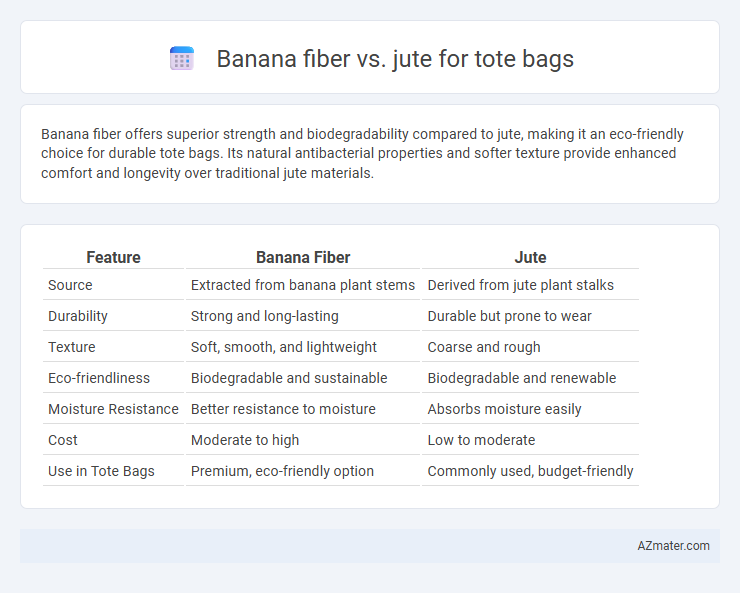Banana fiber offers superior strength and biodegradability compared to jute, making it an eco-friendly choice for durable tote bags. Its natural antibacterial properties and softer texture provide enhanced comfort and longevity over traditional jute materials.
Table of Comparison
| Feature | Banana Fiber | Jute |
|---|---|---|
| Source | Extracted from banana plant stems | Derived from jute plant stalks |
| Durability | Strong and long-lasting | Durable but prone to wear |
| Texture | Soft, smooth, and lightweight | Coarse and rough |
| Eco-friendliness | Biodegradable and sustainable | Biodegradable and renewable |
| Moisture Resistance | Better resistance to moisture | Absorbs moisture easily |
| Cost | Moderate to high | Low to moderate |
| Use in Tote Bags | Premium, eco-friendly option | Commonly used, budget-friendly |
Introduction to Banana Fiber and Jute
Banana fiber, derived from the pseudostem of banana plants, offers a sustainable and biodegradable alternative known for its strength and flexibility, ideal for eco-friendly tote bags. Jute, a natural vegetable fiber obtained from the jute plant, is prized for its coarse texture, durability, and affordability, commonly used in manufacturing sturdy and reusable tote bags. Both fibers provide environmentally conscious options, with banana fiber excelling in softness and jute in ruggedness, catering to diverse tote bag designs and consumer preferences.
Material Origins and Sustainability
Banana fiber, derived from the stalks of banana plants, offers a renewable and biodegradable material for tote bags, often utilizing agricultural waste that would otherwise be discarded. Jute, sourced from the bast fibers of the jute plant, is also highly sustainable due to its fast-growing nature and low water requirements, making it a popular eco-friendly choice for bags. Both materials support sustainable production, but banana fiber's use of crop residues gives it an edge in reducing agricultural waste and promoting circular economy practices.
Fiber Extraction and Processing Methods
Banana fiber extraction involves stripping the outer bark of the banana plant and retting the fibers through water soaking to separate them from the pulp, resulting in strong, flexible fibers ideal for tote bags. Jute fiber processing starts with harvesting the jute stalks, followed by water retting to soften and separate fibers, then drying and combing the fibers for a coarse, durable texture. Both methods rely heavily on retting but yield different fiber qualities, with banana fibers offering smoother, finer strands compared to the rougher texture of jute fibers.
Environmental Impact Comparison
Banana fiber production generates less water pollution and requires fewer pesticides compared to jute cultivation, making it a more eco-friendly option for tote bags. Banana plants also utilize agricultural waste from banana harvesting, reducing overall resource consumption and waste. Jute, while biodegradable and renewable, involves intensive water use and chemical retting processes that contribute to soil and water contamination.
Durability and Strength: Banana Fiber vs Jute
Banana fiber exhibits higher tensile strength and greater durability compared to jute, making it more resistant to wear and tear for tote bags. Its moisture resistance reduces the risk of fiber degradation, while jute tends to weaken when exposed to prolonged humidity. This makes banana fiber tote bags a superior choice for long-lasting, sturdy use in varied environmental conditions.
Texture, Appearance, and Aesthetic Appeal
Banana fiber offers a smooth yet coarse texture with a natural sheen, creating a unique, rustic aesthetic ideal for eco-friendly tote bags. In contrast, jute has a rougher texture with a matte finish, providing a sturdy, vintage look favored in traditional and casual styles. Both fibers are sustainable, but banana fiber's finer weave imparts a more refined and elegant appearance compared to jute's rugged charm.
Weight and Comfort for Everyday Use
Banana fiber tote bags are lightweight and exceptionally soft, providing superior comfort for everyday use compared to jute bags, which are heavier and coarser. The natural smoothness of banana fiber reduces irritation on the skin, making it ideal for prolonged carrying. Jute offers durability but may cause discomfort due to its rough texture and added weight during extended wear.
Biodegradability and End-of-Life Options
Banana fiber and jute both offer excellent biodegradability, making them eco-friendly choices for tote bags that naturally decompose without leaving harmful residues. Banana fiber typically decomposes faster due to its finer structure and high cellulose content, while jute is durable yet still breaks down effectively in composting environments. End-of-life options for these fibers include industrial composting, home composting, and recycling into paper or textiles, supporting circular economy practices and reducing landfill waste.
Cost-Effectiveness and Market Availability
Banana fiber offers a cost-effective alternative to jute for tote bags, often sourced from agricultural waste, reducing raw material expenses and promoting sustainability. Jute remains widely available globally with a well-established supply chain, making it a reliable choice for mass production despite variable price fluctuations due to seasonal yields. The market availability of banana fiber is growing but still limited compared to jute, impacting large-scale adoption and competitive pricing in the tote bag industry.
Which Fiber is Better for Eco-Friendly Tote Bags?
Banana fiber offers superior biodegradability and strength compared to jute, making it an excellent choice for eco-friendly tote bags that require durability and sustainability. Jute remains popular due to its affordability and availability, but banana fiber's softer texture and natural antibacterial properties provide enhanced comfort and hygiene. Choosing banana fiber aligns better with zero-waste initiatives and supports reduced environmental impact through its renewable sourcing and faster decomposition rates.

Infographic: Banana fiber vs Jute for Tote bag
 azmater.com
azmater.com